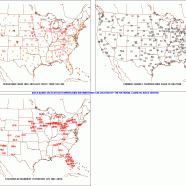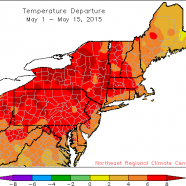Hot Election Day
It’s November…right? It could be snowing right now! Instead we are pushing 70 degrees in Jamestown with it currently in the mid 60s in western New York. Here we have the temperature departures from the 1981-2010 30-year average, the current hourly temperature, and the stations in the warmest 10% vs. the 30-year data. Enjoy it while you’re heading out to vote on this lovely Election Day. Graphic via Penn State Dept. of Meteorology
Read MoreScorching May
The first half of the month of May 2015 was a quietly scorching one, with the heat turned all the way up in the Northeast. You may not believe it based on the outdoor feel of our day to day weather, but the entire region was far warmer than usual. While we did not have the extreme highs or actual heat waves, a stretch or days well into the 90s or anything particularly memorable, we have been consistently warmer than average for our highs and often above the long-term lows. The Northeast Regional Climate Center map here shows us the tale. The coolest part has been sections of Maine which were...
Read MoreTale of Two April Climates
The first half of April 2015 was a Tale of Two Climates: when compared to long-term averages, New England was cool to cold and dry, sometimes exceptionally so, while the Mid-Atlantic was warm and wet, sometimes ridiculously so. Fortunately since then it has balanced out to some degree (pun intended) and conditions have moderated in both regards. In my opinion we seem to be at a relatively average place in terms of “green out”, with buds and leaves near where they “should” be for our returning birds and emerging insects. Scott Kruitbosch Conservation & Outreach...
Read MoreMelanistic House Sparrow (Passer domesticus)
This is one House Sparrow (Passer domesticus) I have never seen before! I took these shots last weekend, the bird being part of a group of well over 100 House Sparrows. The photos are very true to real life appearance and have not been heavily edited. Do you know why it is so dark? It appears to be melanistic which means that the dark-colored pigment melanin in the feathers was produced at higher than normal levels creating an abnormal color. The opposite is known as leucism where pigments are produced at less than normal levels or in an unexpected pattern. Melanism in small songbirds is...
Read MorePurple Finch and Pine Siskin invasion
Two species have recently flooded the Northeast and Mid-Atlantic according to list serv reports, accounts from friends and my own personal observations – the Purple Finch and the Pine Siskin. The former has been unbelievably abundant in my experience, often being difficult to go outside for any length of time without seeing one in the past month. The latter, while a bit tougher to spot, has nonetheless zipped by in sizable groups and maintained their nomadic feeding habits. Just how massive are these irruptions in our region? I turned to eBird to find out the truth. Here are both...
Read More








